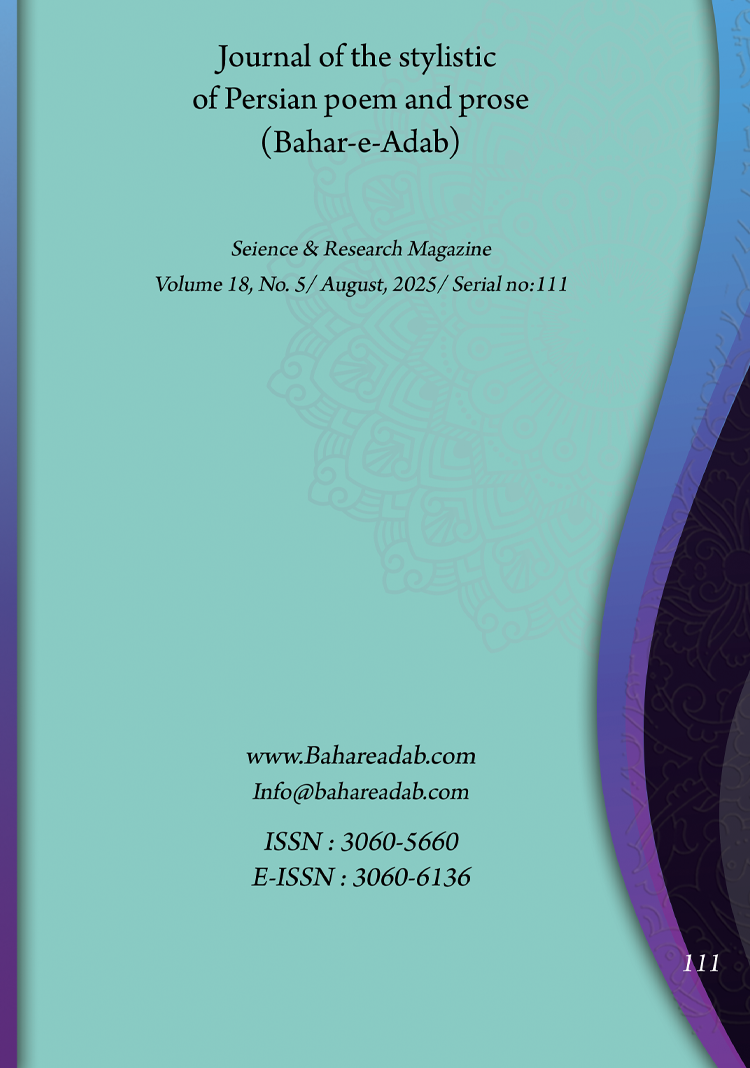- Count View : 16
- آدرس کوتاه شده مقاله: https://bahareadab.com/article_id/1855
- کد doi مقاله: Doi: 10.22034/bahareadab.2025 .18 .7879
Journal of the stylistic of Persian poem and prose
volume Number 18،
number In Volume 5،
،
issue Number 111
Analysis of the Symbols in the Poetry Collection "Sahouri" by Nemat Mirzazadeh (M. Azarm)
Abdullah Vaseq Abbasi (Author in Charge)
Abstract
BACKGROUND AND OBJECTIVES: Nemat Mirzazadeh (M. Azarm) is one of Iran"s committed and socially engaged poets. His poetry collection Sahouri encompasses political and social poems, expressed through a religious perspective and with a symbolic and allegorical language. The title of the collection, derived from Rumi"s Masnavi, is a symbolic allegory of the poet himself, who throughout his life has constantly battled the two demons of time: oppression and ignorance, and has enlightened people with the weapon of his poetry.
METHODOLOGY: This study was conducted in a descriptive-analytical manner, with a library-based approach. The author examines the roots of symbolism in Nemat Mirzazadeh"s poetry, particularly in the collection Sahouri.
FINDINGS: This collection contains symbolic elements whose origins can be traced back to nature, mythology, and religious themes. Nature and its various manifestations are the primary sources of poetic symbols in this collection.
CONCLUSION: Sahouri contains social content and is written as a revolutionary work aimed at fighting against despotism and ignorance, using a symbolic language. The poetry collection, which stands in contrast to the dark night of oppression, raises a cry of enlightenment and signifies that Nemat Mirzazadeh has raised the banner of awakening and is grappling with ignorance and tyranny.
Keyword
Mirzazadeh
, Sahouri poetry collection
, symbolism
, nature.
- Akhavan Thalith, M. (2007). Zemestan, Tehran: Zemestan.
- Baraheni, R. (1987). Roya-ye Bidar, Tehran: Ghatreh.
- Bayat, H. (2008). Dastan-Nivisi Jaryan-e Siyal-e Zehn, Tehran: Elm va Farhangi.
- Tabrizi, S. M. (1977). Maqalat-e Shams, edited by M. A. Mohaqqiq, Tehran: Scientific Publications of Sharif University of Technology.
- Hosseinpour Chafi, A. (2005). Jaryan-haye She'r-e Mo'asir-e Farsi, Tehran: Sepehr.
- Hamidian, S. (2002). Dastan-e Degardisi (Ravand-e Degar-guni-haye She'r-e Nima Yushij), Tehran: Niloufar.
- Khatibi, M. (2006). "Darangi Bar She'r-e Azarm", in Mojmo'e She'r-e Sahouri, Tehran: Afarinesh.
- Dad, S. (2008). Farhang-e Estelahat-e Adabi, Tehran: Mavareed.
- Zarqani, M. (2004). Cheshmandaz-e She'r-e Mo'asir-e Iran, Tehran: Thalith.
- Salajeghah, P. (2010). Naqd-e Novin Dar Hoz-e She'r, Tehran: Mavareed.
- Shamlu, A. (1969). Marsiyeh-haye Khak, Tehran: Amir Kabir.
- Chauvin, J. (2006). Farhang-e Namadh-ha, Vol. 4, translated by S. Fazayeli, Tehran: Jihun.
- Fattouhi Rodmaijani, M. (2014). Balaghat-e Tasvir, Tehran: Sokhan.
- Kazazi, M. J. (2001). Az Koneh-ye Digar, Tehran: Markaz.
- Molavi, J. M. (1989). Masnavi Ma'navi, edited by R. A. Nicholson, Tehran: Moli.
- Mirzazadeh, N. (2006). Sahouri, edited by M. Khatibi, Tehran: Afarinesh.
- Mirsadeghi, J. (2013). Anasir-e Dastan, Tehran: Sokhan.
- Yahagi, M. J. (2012). Joybar-e Lahzeha, Tehran: Jami.

